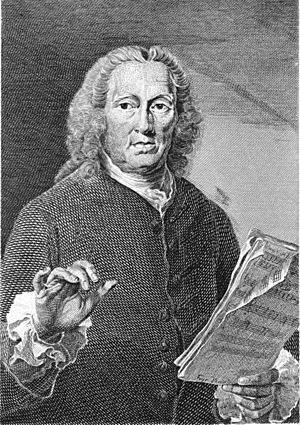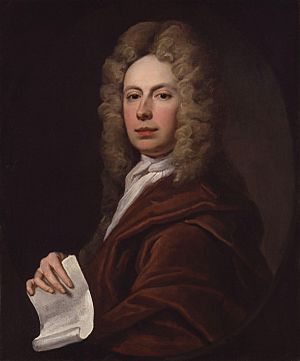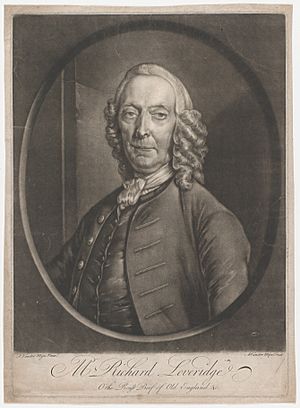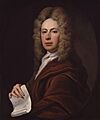Richard Leveridge facts for kids
Quick facts for kids
Richard Leveridge
|
|
|---|---|

Portrait of Richard Leveridge, Engraved by J. Saunders, After Thomas Frye (circa 1710–1762)
|
|
| Background information | |
| Also known as | Richard Leueridge |
| Born | 19 July 1670 St Martin-in-the-Fields, London, United Kingdom |
| Died | 22 March 1758 (aged 87) Holborn, London, United Kingdom |
| Genres | baroque music |
| Occupation(s) | Singer, composer |
| Instruments | bass |
| Years active | 1695–1753 |
Richard Leveridge (born July 19, 1670 – died March 22, 1758) was a famous English singer and composer. He was known for his deep, powerful bass voice. Richard Leveridge performed on the London stage and wrote many popular songs during the Baroque period.
Contents
Richard Leveridge's Early Life and Career
Richard Leveridge was born in London in 1670. By 1695, he became a top bass singer at the Drury Lane theatre. This theatre was run by the United Company. His first major role was as the magician Ismeron in Henry Purcell's opera The Indian Queen. He sang a famous song called "Ye twice ten hundred deities."
Leveridge worked closely with Henry Purcell, a very important composer. It's thought that Purcell wrote the song "Arise, ye subterranean winds" for him. After Purcell's death, Leveridge continued to work with other composers like Daniel Purcell and Jeremiah Clarke. He also started composing his own music.
In 1699, Leveridge helped create music for a play called The Island Princess. His performance in this play, especially a song called 'Enthusiastick Song', was very popular.
Composing and Performing His Own Music
Between 1697 and 1728, Richard Leveridge published several collections of his own songs. Many of his popular theatre songs were also printed separately.
After spending some time in Dublin, he returned to London in 1702. He performed in a new version of The Island Princess. He also starred in a new production of Macbeth. For Macbeth, Leveridge composed all the new music himself. He played the role of Hecate in this play for almost 50 years. The music he wrote for Macbeth stayed popular for over a century!
Performing in Operas
Richard Leveridge continued to sing in revivals of Purcell's operas. These included The Fairy-Queen, Timon of Athens, and King Arthur.
Around 1705, Italian-style opera became popular in London. Leveridge performed in some of these early Italian operas, like Arsinoë and Camilla. Sometimes, these shows had both English and Italian singers. But as Italian opera became fully popular, Italian singers took over the main bass roles.
Leveridge then worked with the famous composer Handel from 1713 to 1714. He performed in Handel's operas Il pastor fido and Teseo. He also played Argantes in a new performance of Rinaldo. Later, in 1731, he sang the role of Polypheme in Handel's Acis and Galatea.
Later Career and Popular Songs
In 1714, Leveridge started working at a new theatre called Lincoln's Inn Fields. He stayed there for most of his career. He went back to performing English plays and a new type of show called a musical Afterpiece. These were usually short, funny plays.
In 1716, Leveridge created his own afterpiece called Pyramus and Thisbe. He wrote the music for this funny play, which was based on Shakespeare's A Midsummer Night's Dream. He also sang the role of Pyramus.
Leveridge also owned a coffee house for a while. But the theatre manager, John Rich, brought him back to the stage. In 1726, Leveridge had a big success in a play called Apollo and Daphne. From then on, he was the main bass singer at Lincoln's Inn Fields and later at the Covent Garden.
His strong voice helped make many of his songs very popular. He is best known for his funny, patriotic song The Roast Beef of Old England. He is also famous for his music for John Gay's song Black Eyed Susan. He wrote over 150 songs in total. These included love songs, hunting songs, and dramatic pieces. Some of his songs had special vocal parts called roulades, which showed off his vocal range.
Richard Leveridge stayed healthy and performed until he retired in 1751. He died in London in 1758, at the age of 87.
What People Thought of Richard Leveridge
People who knew Richard Leveridge often described him as having a very strong voice. He was not known for being graceful or elegant in his singing. Instead, his performances were powerful and full of energy.
He was also known for being a fun person to be around. He enjoyed drinking and telling jokes. Many of his songs and conversations were about enjoying life, not worrying about money, and having a good time. Because of this, he was a popular guest at clubs and parties.
Portraits of Richard Leveridge
There are several portraits of Richard Leveridge. The National Portrait Gallery in London has a painting of him when he was younger, from around 1710–1720. This painting is displayed at the Handel House Museum.
The National Portrait Gallery also has copies of two other pictures of him. These show Leveridge when he was much older. One was made by William Pether after a painting by Thomas Frye. The other was made by Andreas van der Mijn after a painting by Frans van der Mijn. There are also other versions of Thomas Frye's original painting.
Recorded Music by Richard Leveridge
Today, you can find recordings of some of Richard Leveridge's works. These include the songs "Black and gloomy as the grave," "When daisies pied and violets blue," and his most famous song, "The Roast Beef of Old England."
Images for kids
-
Portrait of Richard Leveridge, Engraved by J. Saunders, After Thomas Frye (circa 1710–1762)






